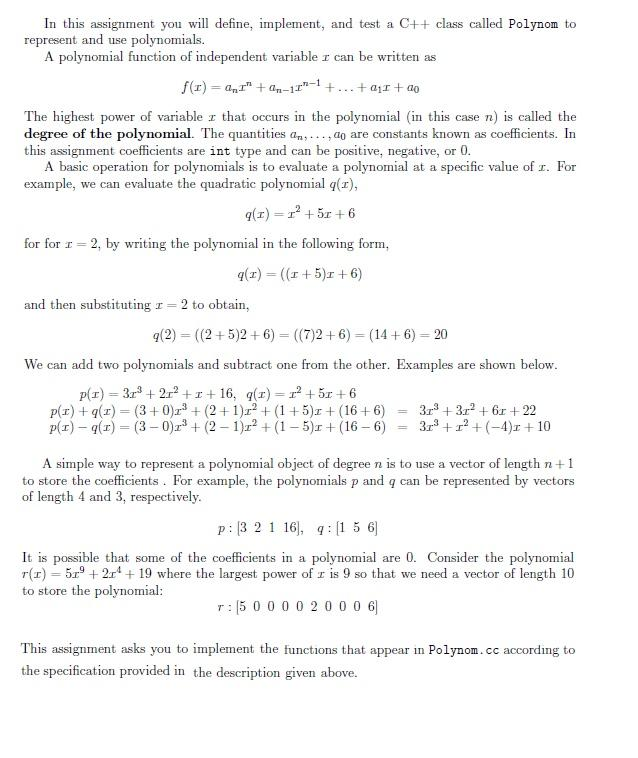Answered step by step
Verified Expert Solution
Question
1 Approved Answer
I want a test program in a file named test_polynom.cc to thoroughly test the member functions of the class Polynom provided below. See the pic
I want a test program in a file named test_polynom.cc to thoroughly test the member functions
of the class Polynom provided below. See the pic If you want to know what the class is about.

Here is the Polynom.cc file that needs a testing file:
#include "Polynom.h" #includeIn this assignment you wl define, implement, and test a C class called Polynom to represent and use polynomials A polynomial function of independent variable r can be written as The highest power of variable r that occurs in the polynomial (in this case n) is called the degree of the polynoial. The quantities an, ao are constants known as coefficients. In this assignment coefficients are int type and can be positive, negative, or 0 A basic operation for polynomials is to evaluate a polynomial at a specific value of r. For example, we can evaluate the quadratic polynomial q(), q(z) =12 + 51 + 6 for for = 2, by writing the polynomial in the following form. q(z) = ((z + 5)| + 6) and then substituting r = 2 to obtain, g(2) = ((2 + 5)2 + 6) = ((72 + 6)-(14 + 6)-20 We can add two polynomials and subtract one from the other. Examples are shown below p(z) + q(z) = (3 + 0)r' + (2 + 1)z? + (1 +5)| + (16+6) 33 + 312 + 6x+ 22 = A simple way to represent a polynomial object of degree n is to use a vector of length n+1 to store the coefficients. For example, the polynomials p and q can be represented by vectors of length 4 and 3, respectively p 3 2 1 16, q 1 5 6] It is possible that some of the coefficients in a polynomial are 0. Consider the polynomial r(r) 5? + 24 + 19 where the largest power of r is 9 so that we need a vector of length 10 to store the polynomial r 5 0 0 0 0 2 0 0 0 6 This assignment asks you to implement the functions that appear in Polynom.cc according to the specification provided in the description given above. In this assignment you wl define, implement, and test a C class called Polynom to represent and use polynomials A polynomial function of independent variable r can be written as The highest power of variable r that occurs in the polynomial (in this case n) is called the degree of the polynoial. The quantities an, ao are constants known as coefficients. In this assignment coefficients are int type and can be positive, negative, or 0 A basic operation for polynomials is to evaluate a polynomial at a specific value of r. For example, we can evaluate the quadratic polynomial q(), q(z) =12 + 51 + 6 for for = 2, by writing the polynomial in the following form. q(z) = ((z + 5)| + 6) and then substituting r = 2 to obtain, g(2) = ((2 + 5)2 + 6) = ((72 + 6)-(14 + 6)-20 We can add two polynomials and subtract one from the other. Examples are shown below p(z) + q(z) = (3 + 0)r' + (2 + 1)z? + (1 +5)| + (16+6) 33 + 312 + 6x+ 22 = A simple way to represent a polynomial object of degree n is to use a vector of length n+1 to store the coefficients. For example, the polynomials p and q can be represented by vectors of length 4 and 3, respectively p 3 2 1 16, q 1 5 6] It is possible that some of the coefficients in a polynomial are 0. Consider the polynomial r(r) 5? + 24 + 19 where the largest power of r is 9 so that we need a vector of length 10 to store the polynomial r 5 0 0 0 0 2 0 0 0 6 This assignment asks you to implement the functions that appear in Polynom.cc according to the specification provided in the description given above#include using namespace std; Polynom::Polynom(){ P.clear() ; // clear the polynomial } Polynom::Polynom(const vector & coeff){ for(int i=0;i =0 and k =0 and k P; while(isspace(ch) == false) { ch = in.peek(); if(ch == '+') { in.ignore(); in >> coefficient; } else if(ch == '-') { in.ignore(); in >> coefficient; coefficient = coefficient * (-1); } else { in >> coefficient; } P.push_back(coefficient); } p = Polynom(P); return in; }
Step by Step Solution
There are 3 Steps involved in it
Step: 1

Get Instant Access to Expert-Tailored Solutions
See step-by-step solutions with expert insights and AI powered tools for academic success
Step: 2

Step: 3

Ace Your Homework with AI
Get the answers you need in no time with our AI-driven, step-by-step assistance
Get Started


